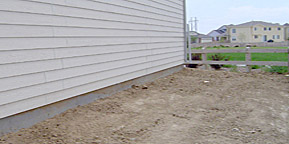Home | About | Services | Gallery | Free Quote | Testimonials | Contact
Establishing proper grade plays a huge role in preventing a wet basement and water damage to your foundation.

The foundation grade is the slope of the land around a home's foundation. A properly established grade slopes away from the home and uses gravity to direct rainwater and snowmelt away from the foundation. Incorrect foundation grading can cause a host of problems, including swamp-like lawns, damp and leaking basements, even cracked foundation walls—all of which are time-consuming and costly to repair.
Backfill against the foundation
- Prepare the area. Remove any debris from the excavation area.
- Use good material. Backfill using material that allows for good drainage. Make sure the backfill contains no organic materials, such as tree roots and vegetation; these materials decompose unevenly, causing the home to settle unevenly and putting additional stress on the footings.
- Layer carefully. Backfill the corners of the foundation first for the greatest support. Then, backfill the remainder of the excavation in layers to promote even settling and minimize stress on the foundation.
Do the rough grade
- Start the rough grade low. Establish the rough grade immediately after backfilling to prevent water from collecting against the foundation and to drain water away from the home.
- Slope the grade. The grade has to be sufficiently sloped to drain water from the lot in accordance with the overall drainage plan for the site.
Do the final grade
- Prepare the area. Before beginning the final grade, remove all debris from the perimeter of the home.
- Maintain the reveal. Make sure the top of the foundation is a minimum of 8†above grade. This prevents the exterior finish from absorbing groundwater, and it is key to the overall strategy of protecting the home from bulk water intrusion.
- Create the slope. Follow the slope already established by the rough grade. Slope the soil in front of the home toward the street. Slope the soil on the sides of and behind the home to the swales. Ensure that the front walks aren't placed too high and that they allow water to drain over, under, or through them.
We solve basement water problems
GRADING IS KEY!
After years of experience dealing with and fixing basement water problems we know that you have to start from the outside and work your way in. Proper grading which allows water to naturally drain away from your home or business is the single most important thing you can do to maintain a dry basement. The ground should slope downward from the house at least 4 inches in the first 6 feet, and no shrubs or trees should be planted closer than 3 feet from the walls (because they absorb water which will eventually make it's way down into your basement).
What if you don't have room for proper grading?
In a location where the terrain itself slopes significantly, it may not be practical to grade the entire area around the house to reroute drainage. In such a case, a shallow valley can be cut about 12 feet out from the wall to catch runoff and route it around the house. This depression need not be severe; a 1-foot-deep trench with gentle sides will channel a great deal of water and will still be easy to mow.
Redo sidewalks or porches that are poorly sloped or loose to the foundation.
It may sound drastic to rip up a sidewalk or porch and replace it, but this is still a much easier undertaking than uprooting the house's footings. Break up the old concrete, and dig down 4 inches below what was the level of the underside of the slab. Lay a 4-inch layer of gravel for drainage, and set the forms for the new concrete so that the new slab or sidewalk will slope away from the foundation wall about 1 inch in 10 feet. Use a watertight expansion joint between the new concrete and the foundation wall.
Investigate and repair the perimeter drain system.
Unless you live in a very dry area, your home's foundation should have a footing perimeter drain. There are two general types: On lots with sufficient slope, the drain may work by gravity, emptying out into a storm sewer downhill from your house's foundation. On level terrain, the perimeter drain should be tied to a sump pump in the basement by drain lines that run under the footing.
Examples of common water problems
Jerry's Landscaping provides complete site services, excavation, backfill, rough, and fine grading. We have a full line of state of the art equipment such as dump trucks, loaders, and dozers all ready to be mobilized to your job site. We would be happy to provide you with a free estimate, our customers are supplied with the most competitive pricing available.
We provide landscaping and grading services to the following Wisconsin counties:
Waukesha, Milwaukee, Racine, Kenosha, Walworth and more depending on the project!
Contact us today for a FREE quote.
© 2025 Jerry's Landscaping and Tree Service. All rights reserved. Contact us | Privacy policy | Site map
